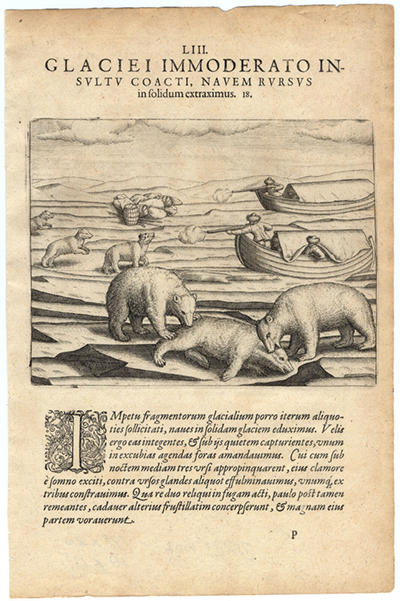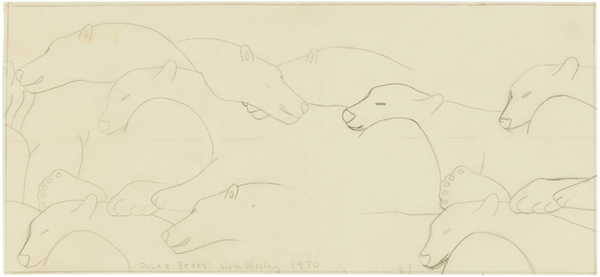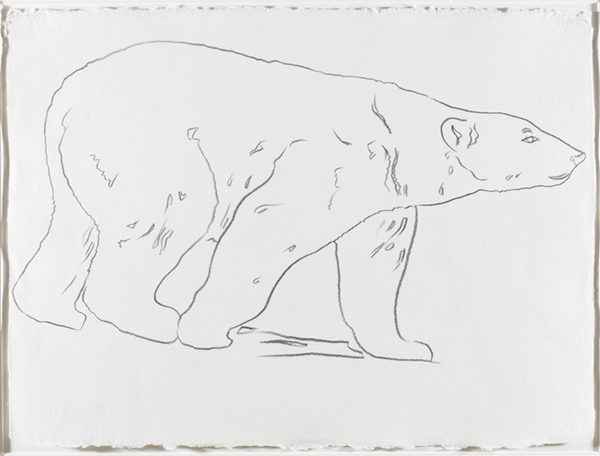Let’s Celebrate! – It’s International Polar Bear Day
By Bowdoin College Museum of Art
Johann Theodor de Bry, LIII Glaciei immoderato insultu coacti, navem rursus, from Indiae Orientalis, part III, copper plate engraving, ca. 1601. Gift of Peter W. Davis, Class of 1957.
It will come as no surprise to Bowdoin students, alumni, and friends that a collection of polar bears is known, quite literally, as a “celebration.” The joyful language also suggests the special regard in which these intriguing animals have long been held by explorers, naturalists, and artists. Indeed, the record of depictions produced by a broad range of western artists since the sixteenth century provides fascinating insight into the multiple mythologies that have coalesced around these creatures.
In 2017, the Museum of Art was fortunate to acquire seventeen historic representations of polar bears from collector Peter W. Davis ’57. This fascinating group of works includes early renditions of the polar bear from the late sixteenth century through the late nineteenth century. Particularly powerful are the engravings of Johann Theodor de Bry which depict the encounter of Dutch explorers with polar bears at Spitsbergen in the mid 1590s. The unfamiliar ursine giants both fascinated and terrified them.
But if de Bry’s prints reflected the sense of vulnerability experienced by Dutch sailors encountering the aggressive animals for the first time, perceptions of the polar bear have changed dramatically in more recent years. Over the past half century, the now endangered species has come to represent the fragility of the natural world in the Anthropocene era. These associations are evident in two drawings by notable pop artists recently added to the collection: John Wesley, Polar Bears, 1970, acquired through the generosity of Eric Silverman ’85 and an anonymous donor; and Andy Warhol, Polar Bear, acquired through the generosity of Jeremy T. Goldsmith ’04, Donald A. Goldsmith ’65, and the Greenacres Acquisition Fund.

In 1970, the year in which John Wesley created Polar Bears, an international cohort of scientists published their conclusion that the bear stood a good chance of surviving extinction if people worked together to protect it. Intriguingly, the artist’s cartoon-like rendition of the “great white bear” actually seems to echo the illustration included in the press release published by the U.S. Department of the Interior announcing this finding. Wesley’s humorous, almost gleeful, drawing of polar bears reflects the artist’s characteristic tendency to begin projects by tracing images on translucent paper. Here, the bears have been removed from any hint of a naturalistic environment, making the bodies themselves the focus of the artist’s attention. The shifting thickness of the line both emphasizes the formal qualities of the polar bears’ bodies, rending them almost sculptural, while the Escher-like repetition simultaneously causes the forms to provoke new associations, suggesting the fragility of the figural image. The light cream color of the paper serves both as ground and as the shade of the bears’ coats. Ears could be refuges, suggesting a protective den of snow. Shapes suggesting feet are difficult to associate with the animals whose profiles appear, suggesting another hidden layer of the creatures and adding to the hilarity of the picture. It becomes challenging to discern whether particular lines define the flank of one bear or the leg of another, and in some instances the outline disappears altogether. Amplifying these perceptual games, the sheer contentedness of the ensemble brings to mind a true celebration.
 Andy Warhol’s solitary polar bear appears to have been traced from a photographic image—a strategy similar to that employed by Wesley. But, transforming his source, Warhol’s composition playfully uses the white of the paper to evoke the animal’s coat and its polar environment. The drawing was likely inspired by an invitation he received to create a screen-print portfolio in 1983, on the tenth anniversary of the Endangered Species Act (ESA). The series ultimately included the African Elephant, Orangutan, San Francisco Silverspot, Black Rhinoceros, Giant Panda, Pine Barrens Tree Frog, Siberian Tiger, Bald Eagle, Bighorn Ram, and Grevy’s Zebra. While the Polar Bear might not have been as rare as Warhol initially believed, the drawing certainly is. And Warhol correctly anticipated that the Polar Bear would be added to the ESA, something that happened in 2008.
Andy Warhol’s solitary polar bear appears to have been traced from a photographic image—a strategy similar to that employed by Wesley. But, transforming his source, Warhol’s composition playfully uses the white of the paper to evoke the animal’s coat and its polar environment. The drawing was likely inspired by an invitation he received to create a screen-print portfolio in 1983, on the tenth anniversary of the Endangered Species Act (ESA). The series ultimately included the African Elephant, Orangutan, San Francisco Silverspot, Black Rhinoceros, Giant Panda, Pine Barrens Tree Frog, Siberian Tiger, Bald Eagle, Bighorn Ram, and Grevy’s Zebra. While the Polar Bear might not have been as rare as Warhol initially believed, the drawing certainly is. And Warhol correctly anticipated that the Polar Bear would be added to the ESA, something that happened in 2008.
These artistic treasures enjoy a fascinating relationship to the polar bear that now stands in Bowdoin’s Buck Center. The specimen was acquired by the arctic explorer, Donald McMillan (Class of 1898) for his alma mater, shortly after its adoption of the polar bear as Bowdoin’s mascot in the wake of Robert Peary’s (Class of 1877) report of his discovery of the North Pole in 1909. If the impressive display of taxidermy allows us to stand shoulder to shoulder with one of these powerful animals, the work of visual artists reminds us of their place in our minds. Perhaps most intriguing is the enduring sway they have long occupied over the human imagination: an invitation to contemplate and perhaps even to attempt the extraordinary—whether discovery new territories or protecting the environment. What more apt emblem, then, for Bowdoin’s own aspiration to intellectual fearlessness? Happy International Polar Bear Day! Let’s celebrate!
Anne Collins Goodyearco-director, Bowdoin College Museum of Art
Illustrations:
Polar Bears, 1970, graphite on tracing paper. Museum Purchase, acquired through the generosity of Eric Silverman ’85 and an anonymous donor.
Polar Bear, 1983, graphite on hmp paper, by Andy Warhol. Gift of Jeremy T. Goldsmith of the Class of 2004 and Donald A. Goldsmith of the Class of 1965 and their Greenacres Acquisition Fund